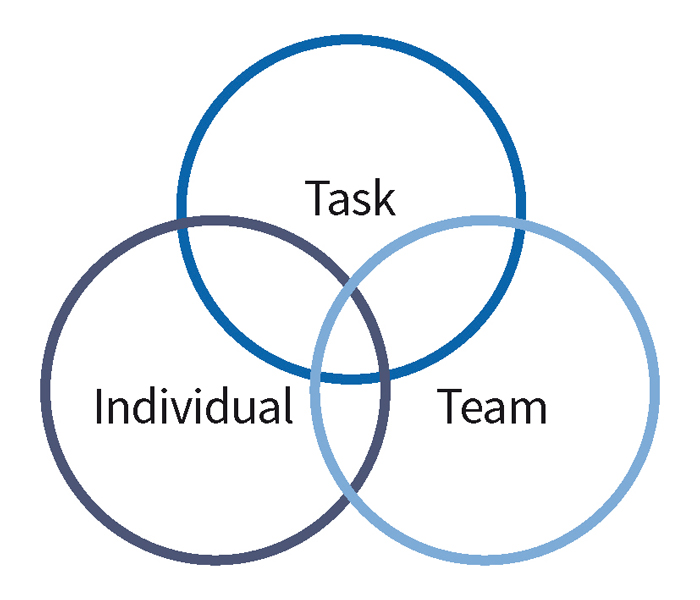1 Jun 2019
Transforming a group of highly talented individuals into a high-performing team is a common challenge in veterinary practices large and small. It requires considered leadership, but also the ability to understand that, sometimes, the best thing to do is nothing at all.

Image © Alexandre Rotenberg / Adobe Stock

The record for the largest castell involved 40 people and reached 10 levels.
The castell may not be what you first had in mind when you thought about high-performing teams. Yes, the castell is certainly high, and it involves a team and it is quite a performance putting one together. But how is that going to help you looking after your practice?
Castells don’t build themselves. A castell is a tower of people, popular in Spain and in Catalonia in particular. They are arranged with forethought and competitions are held. Despite reaching several levels high, relatively few accidents occur.
Those who take part and build these castells have a motto: strength, balance, courage and common sense. They plan it out ahead of time, with the biggest and strongest castellers forming the base. The team pulls together to build the castell, helping each other balance and using a high level of trust.
Courage is called for, as it is often the youngest and smallest who will form the peak. But they are not single-minded in their goal. They know their limitations and when things aren’t going right, so aren’t afraid to exercise common sense.
Much can be learned from the castellers’ approach to building their high-performing teams (literally) in helping you develop your own high-performing teams.
Putting together a high-performing team doesn’t happen by accident. It requires patience and focus. It requires leadership. An excellent approach to leadership can be found in John Adair’s studies and the model he put together, called the action-centred leadership model.
In his book about the model, Adair describes the three stages of leadership that help you identify what a team is and can be. When discussing leadership from a strategic standpoint, this is something that must be done at a full organisational level – no matter how big your organisation is.
This then filters down to a role of operational leadership, which is closer to the client, but may be just a part of the business and may constitute several teams. The team leadership Adair highlights is one of no more than 10 to 12 people; that’s a team you can work with.
You may have a practice where the whole organisation is small enough that you can fulfil all three stages of leadership within the same organisation. There are no written rules, so great. Good for you. Knock yourself out.
It is the three spheres of action-centred leadership that are crucial for you – as a leader – to keep in balance, for you to help your team achieve high performance. As per the diagram, as a leader you have three roles to occupy – and to help your team achieve more, you need to occupy each of these three roles. You may be stronger in certain roles than others, but that is your problem, not the team’s. The team needs you to move and occupy all three spheres.

It’s about setting the appropriate level of challenge. If you are naturally more task-focused, you need to remember that you need to help motivate and develop the individual person within the team; and you have an obligation to the team itself. Your obligation is to build and maintain the team.
Teams aren’t theories. They aren’t units within your business. They are people. They are individuals. And if you want them to perform like a team, you must first respect them as individuals. Teams have a micro-culture they develop themselves; you can only help it along. Grow it. Culture it.
Teams have four hallmarks that allow them to perform:
Do any of the teams you are working with exhibit these hallmarks? If so, great, you have something to work with. If not, can you do anything to help them function better? It may be you don’t have the right chemistry yet within the team.
So, what is your role as a leader? A great adage is attributed to Thomas Paine: “Lead, follow or get out of the way.” This is also true in your role as a leader. You are managing adults. They know what needs to be done (generally) and they know how to do it (mostly). You can guide them, set the objectives and help direct them, but most of all, you need to know when to quit while you’re ahead.
Jim Collins, in his book Good to Great, discusses high-performing teams in great detail, and uses the metaphor of a flywheel to draw an analogy with how companies – and teams – reach a point when their hard work pays dividends.
As with a big, heavy, industrial flywheel, it takes a lot of effort to generate the inertia required to keep the flywheel turning. However, once you’ve got it going around, it takes appreciably less effort to keep it going.
In your role as the leader of a high-performing team, are you willing to put in the effort to help your team get themselves to that high-performing plateau? And if so, are you then prepared to take a backseat and just let them get on with it?
But you do have a role to play in keeping your team happy and motivated. Ultimately, you can’t really motivate your team, just as you can’t motivate another person. Only individuals can motivate themselves. You can only provide the environment for them to find motivation in.
Partly, that is through managing yourself through Adair’s action-centred leadership model; partly, this is through setting achievable objectives that allow teams to stretch themselves, but feel rewarded simultaneously.
People want to be able to have challenges to their role in line with their skills and experience. After all, that is what they were hired for.
Having a fulfilling job – or job enrichment, as Herzberg calls it – is not just motivating, but a key to keeping someone motivated. As such, it isn’t a one-off exercise – it is a continuous process of going back and keeping each person stimulated.
If each individual is stimulated, he or she will be happy (or at least happier), which means he or she will contribute more significantly to the team. And the flywheel starts turning…
Any goal, no matter how challenging, is only achievable for you as a leader through your team. If you want – or need – to set challenging goals, you need a high-performing team.
You may not be building a castell, but if you acknowledge and treat the people within your team as individuals, rather than a pure collective; balance your responsibilities between the person, the task and the team; and remember there is more than keeping your team happy and motivated other than trying to buy them, you are on your way.
Onwards and upwards.